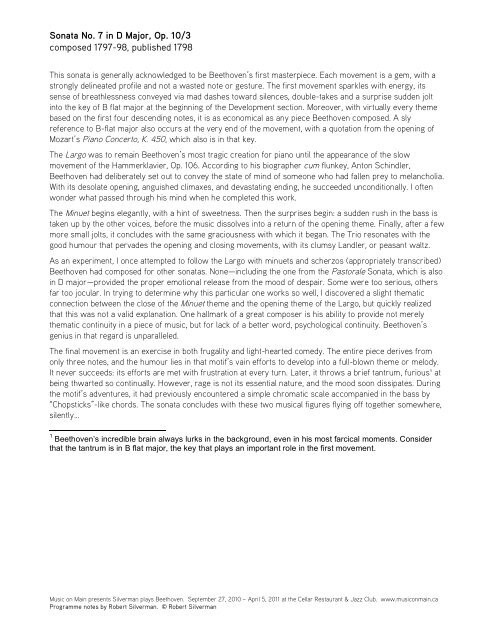beethoven's 32 piano sonatas robert silverman - Music on Main
beethoven's 32 piano sonatas robert silverman - Music on Main
beethoven's 32 piano sonatas robert silverman - Music on Main
You also want an ePaper? Increase the reach of your titles
YUMPU automatically turns print PDFs into web optimized ePapers that Google loves.
S<strong>on</strong>ata No. 7 in D Major, Op. 10/3<br />
composed 1797-98, published 1798<br />
This s<strong>on</strong>ata is generally acknowledged to be Beethoven’s first masterpiece. Each movement is a gem, with a<br />
str<strong>on</strong>gly delineated profile and not a wasted note or gesture. The first movement sparkles with energy, its<br />
sense of breathlessness c<strong>on</strong>veyed via mad dashes toward silences, double-takes and a surprise sudden jolt<br />
into the key of B flat major at the beginning of the Development secti<strong>on</strong>. Moreover, with virtually every theme<br />
based <strong>on</strong> the first four descending notes, it is as ec<strong>on</strong>omical as any piece Beethoven composed. A sly<br />
reference to B-flat major also occurs at the very end of the movement, with a quotati<strong>on</strong> from the opening of<br />
Mozart’s Piano C<strong>on</strong>certo, K. 450, which also is in that key.<br />
The Largo was to remain Beethoven’s most tragic creati<strong>on</strong> for <str<strong>on</strong>g>piano</str<strong>on</strong>g> until the appearance of the slow<br />
movement of the Hammerklavier, Op. 106. According to his biographer cum flunkey, Ant<strong>on</strong> Schindler,<br />
Beethoven had deliberately set out to c<strong>on</strong>vey the state of mind of some<strong>on</strong>e who had fallen prey to melancholia.<br />
With its desolate opening, anguished climaxes, and devastating ending, he succeeded unc<strong>on</strong>diti<strong>on</strong>ally. I often<br />
w<strong>on</strong>der what passed through his mind when he completed this work.<br />
The Minuet begins elegantly, with a hint of sweetness. Then the surprises begin: a sudden rush in the bass is<br />
taken up by the other voices, before the music dissolves into a return of the opening theme. Finally, after a few<br />
more small jolts, it c<strong>on</strong>cludes with the same graciousness with which it began. The Trio res<strong>on</strong>ates with the<br />
good humour that pervades the opening and closing movements, with its clumsy Landler, or peasant waltz.<br />
As an experiment, I <strong>on</strong>ce attempted to follow the Largo with minuets and scherzos (appropriately transcribed)<br />
Beethoven had composed for other <str<strong>on</strong>g>s<strong>on</strong>atas</str<strong>on</strong>g>. N<strong>on</strong>e—including the <strong>on</strong>e from the Pastorale S<strong>on</strong>ata, which is also<br />
in D major—provided the proper emoti<strong>on</strong>al release from the mood of despair. Some were too serious, others<br />
far too jocular. In trying to determine why this particular <strong>on</strong>e works so well, I discovered a slight thematic<br />
c<strong>on</strong>necti<strong>on</strong> between the close of the Minuet theme and the opening theme of the Largo, but quickly realized<br />
that this was not a valid explanati<strong>on</strong>. One hallmark of a great composer is his ability to provide not merely<br />
thematic c<strong>on</strong>tinuity in a piece of music, but for lack of a better word, psychological c<strong>on</strong>tinuity. Beethoven’s<br />
genius in that regard is unparalleled.<br />
The final movement is an exercise in both frugality and light-hearted comedy. The entire piece derives from<br />
<strong>on</strong>ly three notes, and the humour lies in that motif’s vain efforts to develop into a full-blown theme or melody.<br />
It never succeeds: its efforts are met with frustrati<strong>on</strong> at every turn. Later, it throws a brief tantrum, furious 1 at<br />
being thwarted so c<strong>on</strong>tinually. However, rage is not its essential nature, and the mood so<strong>on</strong> dissipates. During<br />
the motif’s adventures, it had previously encountered a simple chromatic scale accompanied in the bass by<br />
“Chopsticks”-like chords. The s<strong>on</strong>ata c<strong>on</strong>cludes with these two musical figures flying off together somewhere,<br />
silently…<br />
1 Beethoven’s incredible brain always lurks in the background, even in his most farcical moments. C<strong>on</strong>sider<br />
that the tantrum is in B flat major, the key that plays an important role in the first movement.<br />
<str<strong>on</strong>g>Music</str<strong>on</strong>g> <strong>on</strong> <strong>Main</strong> presents Silverman plays Beethoven. September 27, 2010 – April 5, 2011 at the Cellar Restaurant & Jazz Club. www.music<strong>on</strong>main.ca<br />
Programme notes by Robert Silverman. © Robert Silverman


